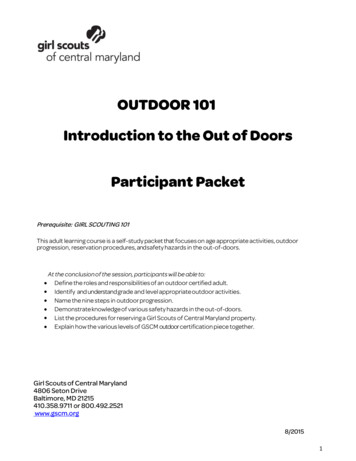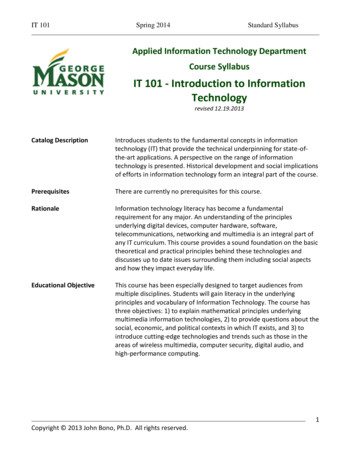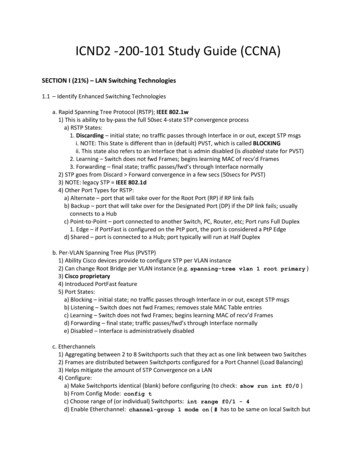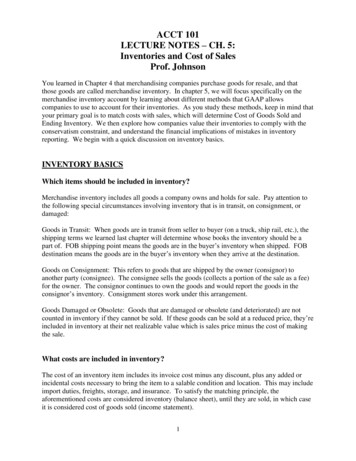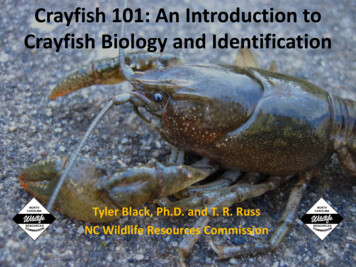
Transcription
Crayfish 101: An Introduction toCrayfish Biology and IdentificationTyler Black, Ph.D. and T. R. RussNC Wildlife Resources Commission
What’s a Crawdad?
Agenda Information Classification/Distribution Biology and Conservation Invasive species impacts Morphology Identification
Information H.H. Hobbs, Jr., 1972 Biota of Freshwater Ecosystems: Identification Manual No. 9.Crayfishes (Astacidae) of North and Middle America. For the Environmental ProtectionAgency, Project #18050 ELD. H.H. Hobbs, Jr., 1989. An illustrated checklist of the American crayfishes (Decapoda:Astacidae, Cambaridae, Parastacidae). Smithsonian Contributions to Zoology 480:1-236. H.H. Hobbs, III, 1991. In Thorp and Covich: Ecology and Classification of North AmericanFreshwater Invertebrates, Academic Press. D.M. Holdich, 2002. Biology of Freshwater Crayfish, Blackwell Science. Taylor et al. 2007. A Reassessment of the Conservation Status of Crayfishes of theUnited States and Canada after 10 Years of Increased Awareness. Fisheries 32(8):372389. Online resources – NCWRC website & Dr. Jim Fetzner – Carnegie MNH Original descriptions
Horton H. Hobbs, Jr.1914 - 1994 200 publications Descriptions 168 Crayfishes ( 46%) 29 genera and subgenera 104 Ostracods 8 Shrimps 6 Crabs And .1 Hush puppy recipe “Oh Hobbs. He writes faster than I can read”
ClassificationPhylum ArthropodaSubphylum CrustaceaClass MalacostracaOrder Decapoda: shrimps, crabs, lobstersSuperfamily Astacoidea – N. HemisphereFamily AstacidaeFamily CambaridaeSuperfamily Parastacoidea – S. HemisphereFamily Parastacidae
Genera of North AmericaAstacidae Pacifasticus (7)Cambaridae Barbicambarus (2)Bouchardina (1)Cambarellus (8)Cambarus (98)Distocambarus (5)Fallicambarus (16)Faxonella (4)Hobbseus (7)Orconectes (90)Procambarus (125)Troglocambarus (1)
Genera of North America(From Hobbs III, 1991)
NC Taxa49 taxa, 4 genera 44 Native (17 type localities) 5 Introduced Cambarus (31) Fallicambarus (1) Orconectes (8) Procambarus (9)
BiologyLife Cycle Egg Immature (direct development) Adult Female Adult Male Form I Form II
General Life CycleSTART HERE!(Hobbs III, 1991)
Moltinghttp://www.crayfishmates.com/crayfish forum/uploads/1232285800/gallery 1 24 92405.jpg
Regeneration and .ID issues
Female vs. MaleAnnulus ventralisGonopodsOrconectes ozarkaeMDC(Ozark Crayfish)
FemaleGonoporesAnnulus ventralisMDC
MaleGonopodsMDCMale Orconectes sp.MDCMale Cambarus sp.
Male I vs. Male IIForm I Reproductively activeCorneousLonger and more definitionFeatherlikeMDCForm II MDCReproductively inactiveReddish or orange tipBluntHard
Female vs. MaleFemaleMaleMDCOrconectes ozarkae (Ozark Crayfish)
ReproductionCambarus batchi(Bluegrass Crayfish)Photos courtesy of MDC
Sperm plugMDCOrconectes quadrucnus (St. Francis River Crayfish)
Glair GlandsMDCFemale Orconectes sp.
Ovigerous“In Berry”
DevelopmentMDCOrconectes luteus (Golden Crayfish) hatchlings
Hatchlings
BiologyDiet Typically considered omnivores and scavengers Carnivores Considerable variation likely
BiologyPredators Fish – 81 species Birds – 77 species Reptiles – 40 species Amphibians – 18 species Mammals – 18 speciesMDCSmallmouth Bass &Orconectes ozarkae
BiologyLongevity Sexual maturity 1 year Life span 5 years Exceptions! Cave dwelling species 20 years?
BiologyHabitat Water Crayfish habitat Streams and rivers Lakes and ponds Wetlands/marshes Ditches Underground burrows Caves Habitat Partitioning Species Age
BiologyHabitat - BurrowsPrimarySecondaryTertiary
ConservationTaylor et al. 2007 363 taxa 2 ( 1%) – Possibly extinct 66 (18%) – Endangered 52 (14%) – Threatened 54 (15%) – Vulnerable 189 (52%) – Stable Federally listed species - 4
ConservationThreats Restricted range Habitat loss and fragmentation Introduced species Disease
Collection Surface waters Seines Traps Dip nets Electrofishing
Collection Burrowers Excavation Traps Hook and Line Night SurveysMDCMDC
Preservation of specimens 70% Ethanol Best for long-term storage Specimens remain flexible 95% Ethanol Higher likelihood of future DNA extraction Specimens become stiff and fragile 40% Isopropanol Ok, but tends to make specimens stiff and fragile Formalin?
MorphologyThe Basics Compound eyes on stalks 10 pr. of appendages (non-feeding) 2 pr. of antennae Two body regions Cephalothorax Abdomen
MorphologyCarapace(From Hobbs, 1976)
MorphologyAreola widthObliterated(Linear)NarrowFrom Hobbs, 1972Wide
MorphologySuborbital angleObsoleteFrom Hobbs, 1972Acute
MorphologyAppendages of the Head 1 pair of mandibles Chewing 2 pair of maxillae Grasp food Baling water 3 pair of maxillipeds Feeding Cleaning Baling water(From Hobbs, 1972)
MorphologyCephalothorax Five pair of walking legs 1st three pair are chelate 1st pair cheliped Each leg with seven segments Coxa, basis, ischium, merus,carpus, propodus, and dactyl(From Hobbs, 1972)
MorphologyAbdomen Pleopods (swimmerets) 1st 5 segments Males – 1st two are modified Females – no modification 6th segment with: Telson (median) Uropods (lateral)(From Hobbs, 1972)
MorphologyIschial hooks(From Hobbs, 1972)
MorphologyChelae Robustness (e.g. slender vs heavy) Dactyl notch Tubercles on palm Rows, shape, number Overall shape of chelae Subtriangular, quadrate, etc. Setae Ridges
MorphologyChelae(From Hobbs, 1972)
om Hobbs, 1972)
How do I view this dang Mudbug?(From Cooper, 2004)
The EndDr. Cooper (NCSM)Chris Riggert (MDC)
In Thorp and Covich: Ecology and Classification of North American Freshwater Invertebrates, Academic Press. D.M. Holdich, 2002. Biology of Freshwater Crayfish, Blackwell Science. Taylor et al. 2007. A Reassessment of the Conservation Status of Crayfishes of the United States and Canada after 10 Years of Increased Awareness. Fisheries 32(8):372-389. Online resources – NCWRC website &


